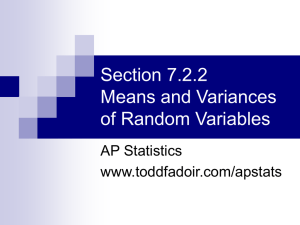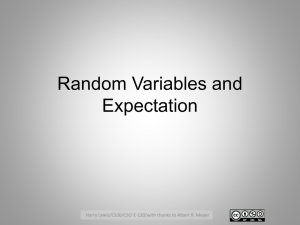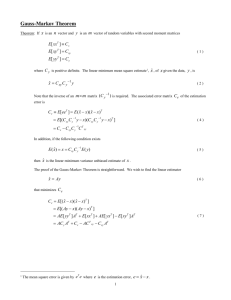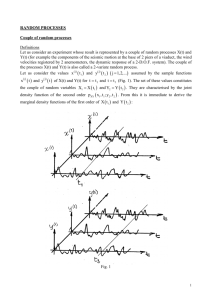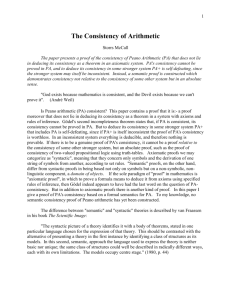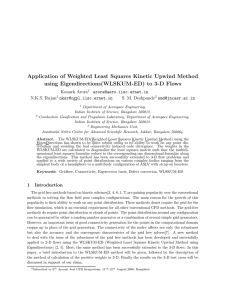Conditional Distributions and Bayesian
advertisement
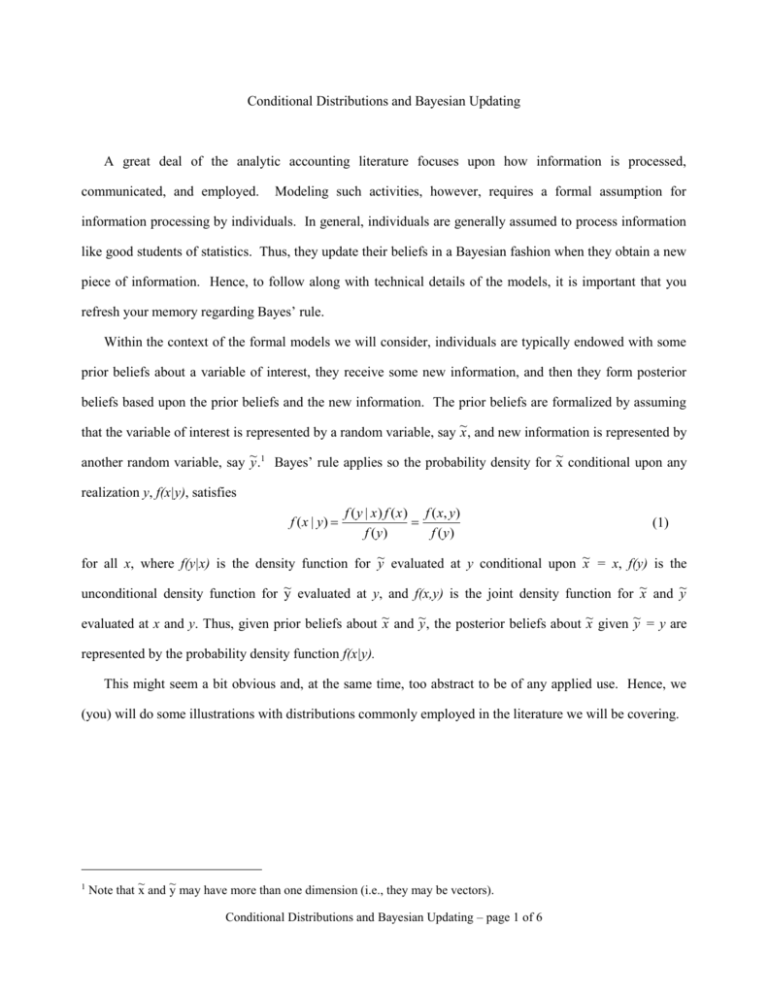
Conditional Distributions and Bayesian Updating A great deal of the analytic accounting literature focuses upon how information is processed, communicated, and employed. Modeling such activities, however, requires a formal assumption for information processing by individuals. In general, individuals are generally assumed to process information like good students of statistics. Thus, they update their beliefs in a Bayesian fashion when they obtain a new piece of information. Hence, to follow along with technical details of the models, it is important that you refresh your memory regarding Bayes’ rule. Within the context of the formal models we will consider, individuals are typically endowed with some prior beliefs about a variable of interest, they receive some new information, and then they form posterior beliefs based upon the prior beliefs and the new information. The prior beliefs are formalized by assuming that the variable of interest is represented by a random variable, say ~x , and new information is represented by another random variable, say ~y .1 Bayes’ rule applies so the probability density for ~ x conditional upon any realization y, f(x|y), satisfies f (x | y) f (y | x) f (x) f (x, y) f (y) f (y) (1) for all x, where f(y|x) is the density function for ~ y evaluated at y conditional upon ~x = x, f(y) is the unconditional density function for ~ y evaluated at y, and f(x,y) is the joint density function for ~x and ~ y evaluated at x and y. Thus, given prior beliefs about ~x and ~y , the posterior beliefs about ~x given ~y = y are represented by the probability density function f(x|y). This might seem a bit obvious and, at the same time, too abstract to be of any applied use. Hence, we (you) will do some illustrations with distributions commonly employed in the literature we will be covering. 1 ~ ~ Note that x and y may have more than one dimension (i.e., they may be vectors). Conditional Distributions and Bayesian Updating – page 1 of 6 Bernoulli Many models employ a simple structure in which the variable of interest has two possible outcomes and the information variable has two possible outcomes (i.e., both are characterized by Bernoulli distributions). Assume the variable of interest ~x has two possible realizations, s or f, where s > f. Let p denote the prior probability of s. Assume that the information received by the decision maker is represented by the random variable ~y , which has two possible outcomes, g or b. Assume that the probability of g conditional upon ~x = s is qg > .5 and the probability of b conditional upon ~x = f is qb > .5. Characterize the posterior distribution for ~x given the following realizations for ~ y. a) ~y = g b) ~y = b c) In a and b, how do qg and qb capture the quality of the information? Uniform Another distribution that is often employed for the variable of interest is the uniform distribution. Assume the variable of interest ~x is uniformly distributed over the range [0,1]. Assume that the information received by the decision maker is represented by the random variable ~y , which has two possible outcomes, b or g. a) Assume that the probability ~ y = b is 1 if ~x [0,k] and the probability ~y = g is 1 if ~x (k,1], where k (0,1). Characterize the posterior distribution for ~ x if ~y = g and the posterior distribution for ~x if ~ y = b. b) Repeat question a assuming that the probability ~y = b is q (.5,1] if ~x [0,.5] and the probability ~ y=g is q if ~ x (.5,1]. Normal A final distribution that is employed heavily in the literature is the normal distribution. The normal distribution is employed because its parameters have nice intuitive interpretations (e.g. it is characterized by a mean and variance and the variance generally serves as a measure of uncertainty and/or quality of information). We will consider the bivariate normal case first and then turn attention to the multivariate case. Conditional Distributions and Bayesian Updating – page 2 of 6 Bivariate Normal Assume prior beliefs about a variable of interested, ~x , and a forthcoming piece of information, ~y , are represented as follows: ~x is normally distributed with mean x and variance sx ~ y is normally distributed with mean y and variance sy, and ~ x and ~y have covariance cxy. Assume that an economic decision maker observes realization y and updates beliefs about ~x . The decision maker’s posterior beliefs are that ~ x is normally distributed with mean x cxy sy (y y ) , and variance cxy2 sx 1 . sx sy To prove this result, note first that, by definition, the joint density function is 2 (x )2 sx sy (x x ) (y y ) (y y ) x . f (x, y) exp 2cxy 2 2 2(sx sy cxy ) sx sy sx sy 2 sx sy cxy 1 Furthermore, by Bayes’ rule we know f(x|y) f(x,y) where the factor of proportionality, f(y)-1, is not a function of x. Therefore, we can work with f(x,y) to derive the conditional density function. Specifically, the conditional density function must be proportional to (x x )2 sx sy (x x ) (y y ) exp 2cxy 2 2(s x sy cxy ) sx sx s y 2 s x sy cxy2 1 sy cxy cxy2 2 2 exp (x ) 2(x ) (y ) (y ) x x y y 2 sy sy2 2(sx s y cxy ) 2 c x x xy (y y ) sy exp 2 cxy 2s x 1 sx sy 2 cxy x x (y y ) sy 1 exp . cxy2 cxy2 2s x 1 2 sx 1 s s sx sy x y Conditional Distributions and Bayesian Updating – page 3 of 6 Note that this last line is the density function for a normally distributed random variable ~ x with the asserted mean and variance. To see if you can apply this result consider the following structures and derive the posterior density for ~x conditional upon ~ y = y. a) ~x is normally distributed with mean x and variance sx. ~y =x~ +~ where ~ is normally distributed with mean 0 and variance s. Also, ~ x and ~ are independent. b) ~x is normally distributed with mean x and precision hx. ~y =x~ +~ where ~ is normally distributed with mean 0 and precision h. (Note: the precision is the inverse of the variance h = s–1.) c) ~x = ~y + ~z , where ~ y is normally distributed with mean y and variance sy, ~z is normally distributed with mean z and variance sz, and ~y and ~z are independent. Multivariate Normal ~ We can extend the bivariate normal case to multivariate normal distributions. Assume that X is an m ~ variate normal with mean vector x and Y is a n variate normal with mean vector My. Let the covariance ~ ~ matrix for X and Y be denoted as Sx C yx C xy Sy ~ ~ where Sx is the covariance matrix for X, Sy is the covariance matrix for Y, and Cxy is the covariance matrix ~ ~ across the elements of X and Y and Cyx is the transpose of Cxy. The decision maker’s posterior distribution for ~ ~ ~ X given Y = Y is that X is an m variate normal with mean x C xy Sy1 (Y y ) , and variance Sx C xy Sy1C yx , where the superscript – 1 denotes the inverse of the matrix. The proof is analogous to the proof in the bivariate case and is omitted. To make the statement more concrete, however, we will provide a specific example. Consider a case where the variable of interest is represented by the random variable ~x and the decision maker obtains two pieces of information represented Conditional Distributions and Bayesian Updating – page 4 of 6 by the random variables ~y and ~z . Denote the mean and variance of random variable i as I and si respectively. Denote the covariance between variables i and j as cij. The covariance matrix is sx cxy cxz cxy sy cyz cxz cyz sz To see the mapping between this matrix and the generic matrix, substitute sx in for Sx, cxy cxz sy c yz cyz sz in for Cxy and in for Sy. Applying the formula, the distribution for the variable of interest ~x conditional on realizations y and z is normal with mean x s c z xy cxz cyz s y sz c 2 yz (y ) s c y xz y cxy cyz s y sz c 2 yz (z ) , z and variance sx sy sz sx cyz2 sy cxz2 sz cxy2 2cxy cxz cyz sy sz cyz2 . To test your ability to apply the formula, derive the posterior expectation and variance for ~x conditional on realizations y and z. a) ~x = ~y + ~z , where ~ y is normally distributed with mean y and variance sy, and ~z is normally distributed with mean z and variance sz. ~ , where ~x is normally distributed with mean and variance s , and ~ is normally b) ~y = ~x + ~ and ~z =x~ + x x ~ is normally distributed with mean 0 and variance s , and ~x , ~ distributed with mean 0 and variance s, ~ are mutually independent. and ~ , where ~x is normally distributed with mean and variance s , and ~ is normally c) ~y = ~x + ~ and ~z =~ + x x ~ is normally distributed with mean 0 and variance s , and ~x , ~ distributed with mean 0 and variance s, ~ are mutually independent. and Conditional Distributions and Bayesian Updating – page 5 of 6 Summary Bayesian updating is a common assumption employed in most of the literature we will consider. By forcing you to work through these notes, I hope you have refreshed your memory regarding Bayesian updating. Furthermore, by focusing your attention on some commonly used distributions, you should have a jump on and a reference for subsequent papers we will cover. Conditional Distributions and Bayesian Updating – page 6 of 6

